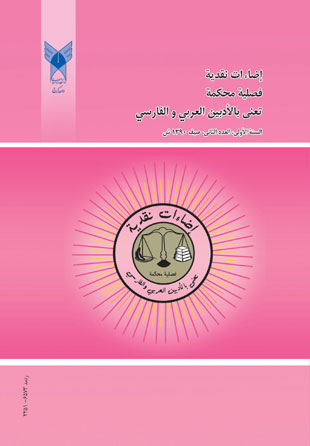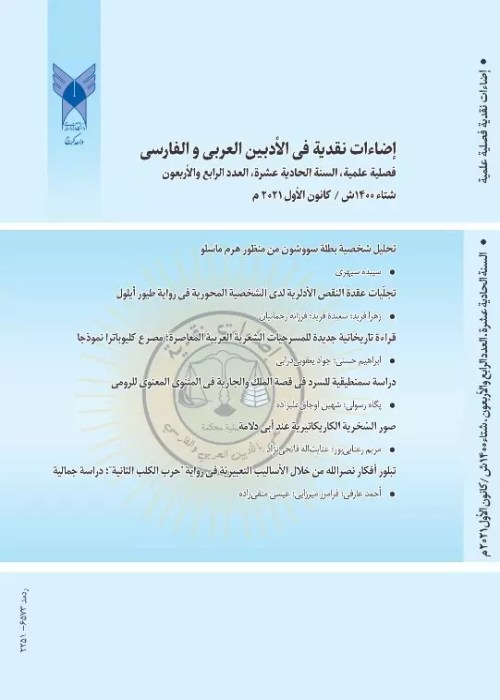فهرست مطالب

فصلنامه إضاءات نقدیه فی الادبین العربی و الفارسی
پیاپی 2 (صیف 2011)
- تاریخ انتشار: 1390/04/25
- تعداد عناوین: 8
-
-
صفحات 9-31
-
صفحات 33-49
-
صفحات 93-107
-
صفحات 127-144
-
Pages 9-31Assistant professor, Islamic Azad University, Garmsar Branch Language is a means of interaction, understanding, and coexistence among people. The language of any nation mirrors its thoughts and ideas and is a manifestation of its pride in various literary, social, political respects. Evidently, the honor of any nation lies in its language. The same is also true for the survival of the nation, which again is intermingled with the perpetuity of its language. Nations with a rich cultural heritage and ancient civilizations have always attempted to attract (by any means) the attention of other nations to themselves. There are various viewpoints as to the origin of language, whether it has been a revelation or an intuition, or else it is created spontaneously or in a gradual form. Arabic, among other languages, is derivative in nature, and has amazing sound-sense congruence. Unfortunately, due to the death of many of its users and the fact that many Muslims were busy with expansion of Islam, majority of its words have faded away. Meantime, owing to the mixture of Arabs and non-Arabs, a lot of loanwords have entered into Arabic; the difference between Basri and Kufi syntacticians has also had a negative influence on Arabic.Keywords: language, origin of language, classification of languages, Arabs before Islam, Basri, Kufi syntacticians
-
Pages 33-49Farid-o-din Attar Neishabouri is deemed amongst the most renowned men in the history of mysticism and Iranian literature. He devotes a faithful consideration to the permeation of mystical thoughts. Relying on divergent allegories and theosophical fables, he depicts the mystic’s journey to achieve truth. However, among the masters of Persian poetry the life of no poet has been as obscure as that of Attar. Furthermore, there has been some irrelevant verse attributed to him, with which he has no concern. The present paper is an attempt to portray Attar’s true personality through the investigation of his works and to trace the very essence of his mystic thoughts in his verse.Keywords: Attar, Biography, poetic style
-
Pages 51-61Contemporary literary circle has grown so vast that there is no way to cover it all at one instance. Discussions about all literary methods in fields such as poetry, essay, journalism, drama, and fiction are of critical issues. Introducing literary scholars in the field of literature and offering their point of view and uncovering their notions may provide valuable insight toward these methods, identifying right and wrong. Of these scholars who has a significant role in literature and criticism, and has valuable point of views about literary works in different age of Persian literature the name Abdolhosein Zarinkoob is no doubt the first to recall. His profound knowledge of English, Arabic, and French languages emancipated Persian literary criticism from restrictions and limitations which led subjective criticism into an objective one, and paved the way for contemporary literary criticism. Some of his perspectives are presented in this paper.Keywords: proper critic, improper critic
-
Pages 63-78Through a detailed investigation in the contemporary Arabic literature during 20th century it can be inferred that literature and art has developed remarkably towards innovation and away from imitation. It is natural that this lunge has not occurred overnight. In fact, in literature no change is feasible without the proper and sufficient background. These backgrounds provide the new tendencies and dimensions in literary arena. Among these the impact of Divan literary society as followers of some special schools is undeniable. As the pioneer of inventiveness and novelty Divan literary society has achieved vehement thoughts such as horizontal and vertical cohesion of the poem, personal poetic experiences, poetic formalism, freedom of interpretation, the originality of conscience,etc through a comprehensive analysis and speculations on contemporary western literature as well as the pure Arabic literature. The Society paved the way for the emergence of new literature regardless of some failure at the outset and opened up a new literature, incomparable to the past. On the road to success, some other literary societies in West and East cooperated to wear the tattered coat of imitation off the weary body of literature and poetry.Keywords: Divan Society, Literary Criticism
-
Pages 79-91
Shahrazad one of the subjective plays by Tawfiq-al-Hakim deals with the conflict between man and environment which ends up with the victory of environment over man. Hakim believes that a force dominates man and it is the existence of a divine power which inspires and guides him. With his Oriental spirit Hakim keeps faith in occult powers depicted in Shahrazad dealing with the conflict between man and environment and the ultimate defeat of man. Hakim concludes the war of opposing forces such as conscience and mind and head and heart with the final triumph of environment.
Keywords: Human crisis, conflict, Shahrazad, Tawfiq, al, Hakim -
Pages 93-107In the ninth century (A H) an adept poet and perfect mystic emerged in Iran which left various poetic and prose works behind him, providing scientific references for literature and mysticism seekers up to now. He is Abdurrahman Jami who was born in 817 in Jam at a knowledgeable and pious atmosphere, starting his studies from childhood with his father. He entered scientific assemblies then and was apprenticed to great masters and learned various sciences such as religious jurisprudence, philosophy, wisdom and others. He enjoyed a good command of composing poetry which elevated him to the highest literary ranks among Persian speaking poets. Because of his interest in Sufism, he joined a famous and important sect among other mystical sects, where well known Sheikhs of Sufism attended there. Jami carried on their path to become a Sheikh of Sheikhs and a disciple of followers of God’s pathway during his old age. He has numerous poetic and prose works, denoting his literal capability and implying his mystical tendencies as well. Among these works we can mention collection of poems including lyrics, quatrains, odes and couplets. These poems are abundant in advice, wisdom and pure love to life origin and destination (God). Jami lived 81 years and passed away in Herat in 898, and was buried there.Keywords: Jami, Sufism, Mysticism, Gnostic, Poet, Author
-
Pages 109-125During the end of nineteenth and the beginning of twentieth century the great majority of people from Arabic lands specifically Lebanon and Syria migrated to the American continent and settled down in Canada, Brazil, Argentina, and Mexico. These folk migrations were mostly an escape from economical, social, and intellectual crisis which dominated the Arab society. Among these immigrants, there existed some literary men and poets who transmitted their literary heritage to the newly moved lands. Being known as an obscure poet they created a species of literature which was profoundly affected by the catastrophic milieu of people from Palestine. The shadow of the classical Arab poets falls so immensely upon the character and poetic style of Ferhat that he fails to emancipate himself from it. The verse stories of Ferhat are vivid portrayals of various facets of his own era and reflect his personal experiences in an ample scope.Keywords: Lebanon, Elias Farhat, migration, classical literature, verse stories
-
Pages 127-144“Khamriyat” is a term referred to poems which deal with the wine world and issues concerned with, from the consideration of form, taste, and smell to diverse cups and bowls applied to preserve or drink it. Moreover, reference to wine-drinking communities, the recollection of cup- bearers, singers,musicians, dancers, discussions on the purity of wine, its effect on human soul and body, and the ecstatic drunkenness accompanied by spiritual drunkenness are all issues elaborated in this type of poetry. No doubt, Abu Nuwas, the great Iranian poet who lived during the second century(A.D) is the forerunner of wine poetry. His outstanding privileges compared to those of his co- poets are that first, he establishes wine poetry as a poetic skill, and next he sets it as a symbolic system. Apart from the realm of poetry, he enters the realms of politics, ethics, and morality and boldly utters some unheard attitudes in a highly restricted milieu. Surely, “Khomriyat” is the mirror of the poet’s era. Due to the significance of these everlasting poems, the present paper examines the structure of his poetry. The content of his poems will be discussed in another paper.Keywords: Khamriyat, Abu Nuwas, wine poetry


